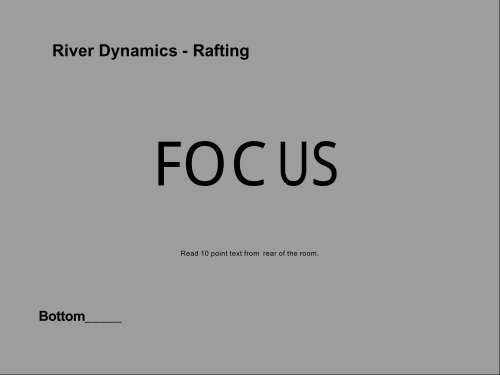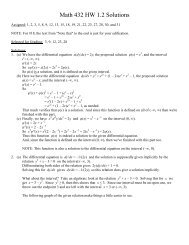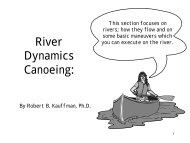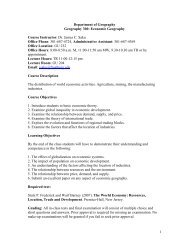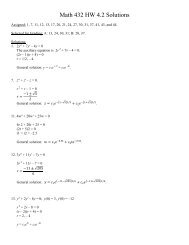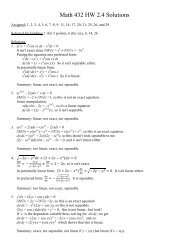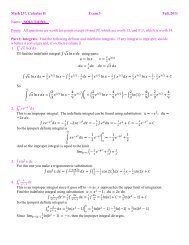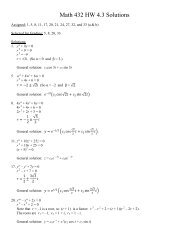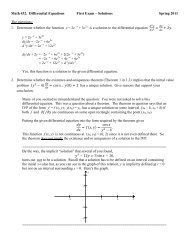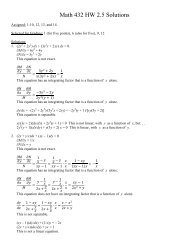River Dynamics - Rafting - Frostburg
River Dynamics - Rafting - Frostburg
River Dynamics - Rafting - Frostburg
Create successful ePaper yourself
Turn your PDF publications into a flip-book with our unique Google optimized e-Paper software.
<strong>River</strong> <strong>Dynamics</strong> - <strong>Rafting</strong><br />
FOCUS<br />
Read 10 point text from rear of the room.<br />
Bottom_____<br />
1
<strong>River</strong><br />
This section focuses on<br />
rivers; how they flow and on<br />
some basic maneuvers which<br />
you can execute on the river.<br />
<strong>Dynamics</strong><br />
<strong>Rafting</strong>:<br />
By Robert B. Kauffman, Ph.D.<br />
2
Topics -<br />
• Laminar and shore to<br />
center flows<br />
• High and low flows<br />
• Current piling up on the<br />
bends<br />
• Strainers<br />
• Pillows<br />
• Eddys<br />
• Hydraulics<br />
• Running the river.<br />
The items on the left<br />
provide a general<br />
discussion of the topics in<br />
this section.<br />
3
Laminar Flows:<br />
• Imagine several sheets of<br />
plywood with wooden dowels<br />
between the sheets<br />
• Push the stack<br />
• The sheets move at<br />
different speeds<br />
• Their speeds are additive...<br />
• With the sheet on the<br />
bottom traveling the<br />
slowest<br />
• Each sheet travels faster...<br />
(continued next slide)<br />
SURFACE<br />
RIVER BOTTOM<br />
4
Laminar Flows:<br />
The air slows slightly the sheet<br />
just below the surface<br />
This creates a depression or void<br />
(shore to center flows - next slide)<br />
The stack is pushed<br />
The bottom sheet<br />
moves the slowest,<br />
slowed by the bottom<br />
The next sheet moves<br />
its speed plus the<br />
speed of the sheet<br />
below it<br />
Fastest water is just<br />
below the surface.<br />
SURFACE<br />
RIVER BOTTOM<br />
5
Shore to Center Flows:<br />
Laminar flow in center of an<br />
unobstructed channel<br />
Slower surface flow creates a<br />
slight depression which draws<br />
water in from sides to fill the<br />
depression<br />
Most likely to occur in drainage<br />
ditches and irrigation channels;<br />
fastest water is just below<br />
surface.<br />
6
Normal Summer Low Flows:<br />
Gauge Level: 1 foot<br />
Time of Year: Summer<br />
<strong>River</strong> has little apparent flow;<br />
often seems pool like<br />
Vegetation on gravel bar<br />
is summer growth of<br />
annuals and other nonpermanent<br />
vegetation.<br />
7
Flood Flows:<br />
<strong>River</strong> is over its primary banks,<br />
into trees and other vegetation<br />
along the banks<br />
Gauge Level: 16 foot<br />
Time of Year: Summer<br />
<strong>River</strong> looks like it is<br />
flooding. Muddy water, big<br />
waves, large objects<br />
floating down the river.<br />
8
Drowning Trap Flows:<br />
Close examination reveals a distinct<br />
current. The river is not over its<br />
primary banks<br />
Gauge Level: 4 foot<br />
Time of Year: Summer<br />
Summer growth on gravel<br />
bar is usually covered with<br />
water indicating higher<br />
summer flows than normal.<br />
9
Normal Flow:<br />
The river is flowing within its<br />
primary and secondary banks<br />
The faster current is in the<br />
center of the main channel.<br />
10
Flood:<br />
<strong>River</strong> is over primary banks;<br />
trees are in water; fast muddy<br />
water with waves and debris<br />
Most people associate<br />
dangerous conditions like<br />
these with flood conditions.<br />
11
Flood with Levees:<br />
Buildings on the banks require<br />
protection. However, the<br />
current becomes extremely<br />
fast, particularly during high<br />
water<br />
Note: effect is to create<br />
the center of the channel<br />
river wide… very<br />
dangerous.<br />
12
The Current<br />
Piles Up on<br />
the <strong>River</strong><br />
Bends:<br />
• Main current starts<br />
center and plows into<br />
bend<br />
• Under cuts bend<br />
• Encourages strainers<br />
and undercut rocks<br />
• Profiles (A,B) next<br />
slide.<br />
<strong>River</strong><br />
Right<br />
<strong>River</strong><br />
Left<br />
13
The Current<br />
Piles Up on<br />
the <strong>River</strong><br />
Bends:<br />
• Undercuts bank<br />
on right<br />
• Fastest current<br />
close to bank<br />
• Shallower and<br />
slower water on<br />
left- inside of<br />
bend.<br />
14
Strainers:<br />
• A strainer is anything<br />
which allows water to<br />
pass through but not<br />
you<br />
• Examples: tree,<br />
branches, old bridges,<br />
just about anything<br />
• Current forces you to<br />
outside of bend and into<br />
the strainer.<br />
<strong>River</strong><br />
Right<br />
<strong>River</strong><br />
Left<br />
15
Pillows -<br />
• Water flows<br />
downstream and piles<br />
up against rock<br />
obstruction<br />
• This water or “pillow”<br />
can create a cushion<br />
for boaters and<br />
swimmers.<br />
Pillow<br />
<strong>River</strong><br />
Right<br />
Pillow<br />
<strong>River</strong><br />
Left<br />
16
Eddys:<br />
• Formed behind an<br />
obstruction (e.g. rock,<br />
bridge abutment, etc.<br />
• Current fills in void<br />
behind the rock<br />
• Eddie line occurs<br />
where the two<br />
currents interface<br />
(see parts on next slide)<br />
• Current flows out<br />
rear of eddy.<br />
<strong>River</strong><br />
Right<br />
<strong>River</strong><br />
Left<br />
17
Parts of an<br />
Eddy:<br />
• Upstream current (1) -<br />
current rushes by rock<br />
creating a void behind<br />
the rock; it fills the void<br />
• Neutral Current (2) -<br />
current doesn’t flow<br />
upstream or downstream<br />
• Downstream Current (3)<br />
- initially a slight<br />
movement<br />
• Eddy Line - where<br />
downstream and<br />
upstream currents<br />
interface or meet.<br />
<strong>River</strong><br />
Right<br />
<strong>River</strong><br />
Left<br />
18
Eddy/Micro Currents:<br />
Current fills in<br />
behind the<br />
obstruction (Eddy<br />
A/B)<br />
Submerged<br />
obstruction creates a<br />
hydraulic/eddy/still<br />
water current (Eddy<br />
C).<br />
19
Types of Holes:<br />
Smiling Hole – Easy<br />
exit at sides (A)<br />
Horizontal Hole – Similar<br />
to low head dam… can be<br />
nasty (C)<br />
Frowning Hole – Moves you to center<br />
and maximizes hole’s force (B)<br />
Diagonal Hole – Moves<br />
you downstream and out<br />
of hole (D)<br />
20
Holes and Hydraulics:<br />
• Boil (2) – neutral area where water neither flows upstream or<br />
downstream<br />
• Downstream Flow (3) – some water continues to flow downstream<br />
• Hole or Hydraulic (1) – some water flows back upstream and<br />
catches the downstream flow<br />
Hole or<br />
Hydraulic<br />
Boil<br />
<strong>River</strong> Bottom<br />
21
Holes and Hydraulics:<br />
• Boil (2) – neutral area where water neither flows upstream or<br />
downstream<br />
• Downstream Flow (3) – some water continues to flow downstream<br />
• Hole or Hydraulic (1) – some water flows back upstream and<br />
catches the downstream flow<br />
• Canoe side surfing a hole.<br />
<strong>River</strong> Bottom<br />
22
Hydraulics/Low Head Dam:<br />
• Boil (2) – neutral area where water neither flows upstream or<br />
downstream<br />
• Downstream Flow (3) – some water continues to flow downstream<br />
• Hole or Hydraulic (1) – some water flows back upstream and<br />
catches the downstream flow<br />
• To avoid – portage, portage, portage…<br />
• Paddle hard - up and over the boil (hopefully you will make it).<br />
Hole or<br />
Hydraulic<br />
Boil<br />
Low Head Dam<br />
<strong>River</strong> Bottom<br />
23
Standing Waves:<br />
Channel<br />
constriction<br />
followed by<br />
widening in the<br />
channel dissipates<br />
energy into waves<br />
This scene has two<br />
eddies on each side<br />
of main current;<br />
you can use these<br />
to surf the waves.<br />
24
Upstream and<br />
Downstream Vs:<br />
• Look for upstream Vs<br />
• And avoid downstream Vs<br />
• Hydraulics<br />
• Best route: upstream V;<br />
three downstream Vs;<br />
downstream V.<br />
<strong>River</strong><br />
Right<br />
<strong>River</strong><br />
Left<br />
25
<strong>River</strong> Running<br />
Topics -<br />
• Positions in a raft<br />
• Negotiating a river<br />
bend<br />
• Eddy turns and peel<br />
outs<br />
• Ferrying<br />
• Running the river.<br />
The items on the left<br />
provide a general<br />
discussion of the topics in<br />
this section.<br />
26
Seek the following:<br />
• Balance paddler<br />
strength<br />
• Seek even weight<br />
distribution (trim)<br />
• Provide adequate<br />
space to paddle<br />
• Captain in rear<br />
and/or on paddling<br />
side.<br />
Positioning in Rafts:<br />
27
Negotiating a<br />
<strong>River</strong> Bend:<br />
• Slower current is on<br />
inside of bend<br />
• Set ferry angle toward<br />
the inside of the bend…<br />
• Paddle “back left;<br />
forward right”<br />
• As current pushes you<br />
to outside, “all back<br />
paddle”<br />
• Straighten boat with<br />
“forward left” and “back<br />
right”<br />
• Continue down the river.<br />
<strong>River</strong><br />
Right<br />
<strong>River</strong><br />
Left<br />
28
Eddy Turn and<br />
Peel Out:<br />
• Boat heading down the<br />
river<br />
• Set boat angle at<br />
approximately 45%<br />
angle to current<br />
• Paddle forward across<br />
eddy line into eddy<br />
• Peel Out: “back right”;<br />
“forward left ”<br />
• Straighten boat with<br />
same stokes as needed<br />
• Continue down the river.<br />
<strong>River</strong><br />
Right<br />
29<br />
<strong>River</strong><br />
Left
Ferrying:<br />
• Used to traverse a<br />
river<br />
• Taught line stretched<br />
across the river<br />
• Pulley system lowers<br />
one end<br />
• Vector force –<br />
downstream and<br />
horizontal<br />
<strong>River</strong><br />
Right<br />
Back Ferry to<br />
<strong>River</strong> Left<br />
Back Ferry to<br />
<strong>River</strong> Right<br />
<strong>River</strong><br />
Left<br />
• Moves ferry across the<br />
river<br />
• Back Ferries.<br />
30
Ferry <strong>River</strong> Right<br />
to <strong>River</strong> Left:<br />
• Peel Out: “back right”;<br />
“forward left”; maintain<br />
forward momentum<br />
• “All forward”<br />
• Slide into eddy on river<br />
left<br />
• Keep forward<br />
momentum so that you<br />
don’t drift out of the<br />
eddy.<br />
<strong>River</strong><br />
Right<br />
<strong>River</strong><br />
Left<br />
31
Back Ferrying<br />
Your Way Down<br />
the <strong>River</strong>:<br />
• Look for upstream Vs<br />
and avoid downstream Vs<br />
• Back ferry river right to<br />
avoid the hydraulic<br />
• Back ferry river left to<br />
setup for next drop…<br />
drop through… back<br />
ferry to avoid rock<br />
• Back ferry river right to<br />
setup and avoid drifting<br />
onto rocks … realign<br />
• Drop though drop and<br />
back ferry to shore.<br />
<strong>River</strong><br />
Right<br />
<strong>River</strong><br />
Left<br />
32
Eddy Turning<br />
Your Way Down<br />
the <strong>River</strong>:<br />
• Set angle to eddy out<br />
behind rock<br />
• Eddy out above hydraulic<br />
and forward to river right<br />
• Peel out and catch eddy<br />
on river right<br />
• Ferry across current to<br />
river left… eddy out…<br />
peel out or drift out<br />
bottom of eddy<br />
• Drop though drop and<br />
forward ferry to shore<br />
in eddy current.<br />
<strong>River</strong><br />
Right<br />
<strong>River</strong><br />
Left<br />
33
This was a quick primer of<br />
the dynamics of rivers and<br />
how to make some moves on<br />
moving water.<br />
The End<br />
34


